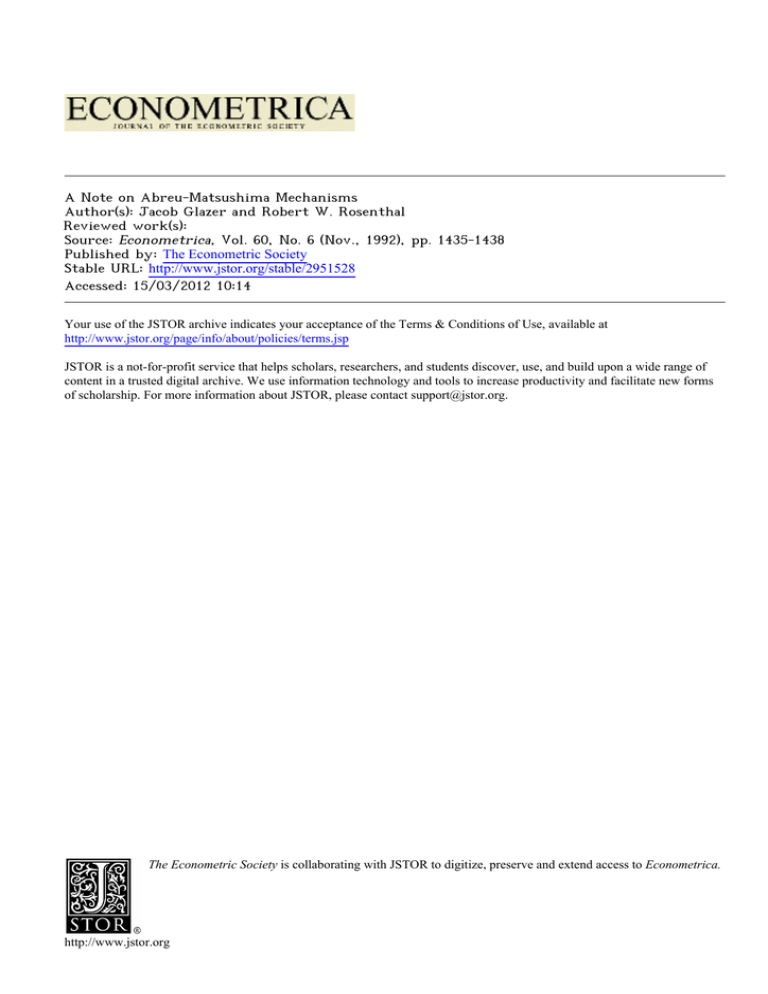A Note on Abreu-Matsushima Mechanisms Reviewed work(s):
advertisement

A Note on Abreu-Matsushima Mechanisms
Author(s): Jacob Glazer and Robert W. Rosenthal
Reviewed work(s):
Source: Econometrica, Vol. 60, No. 6 (Nov., 1992), pp. 1435-1438
Published by: The Econometric Society
Stable URL: http://www.jstor.org/stable/2951528 .
Accessed: 15/03/2012 10:14
Your use of the JSTOR archive indicates your acceptance of the Terms & Conditions of Use, available at .
http://www.jstor.org/page/info/about/policies/terms.jsp
JSTOR is a not-for-profit service that helps scholars, researchers, and students discover, use, and build upon a wide range of
content in a trusted digital archive. We use information technology and tools to increase productivity and facilitate new forms
of scholarship. For more information about JSTOR, please contact support@jstor.org.
The Econometric Society is collaborating with JSTOR to digitize, preserve and extend access to Econometrica.
http://www.jstor.org
Econometrica, Vol. 60, No. 6 (November, 1992), 1435-1438
NOTES AND COMMENTS
A NOTE ON ABREU-MATSUSHIMA MECHANISMS
BY JACOB GLAZER
AND ROBERT
W.
ROSENTHAL1
IN A STIMULATING RECENT PAPER, Abreu and Matsushima (1992) (hereafter A-M) show
how a class of social choice functions can be virtually implemented in iteratively
undominated strategies. This work has several important features: the mechanisms used
are finite and not too difficult to understand, and so less objectionable in this regard than
many in the literature; the class of social choice functions implemented is large; and the
solution concept-Nash equilibrium determined uniquely by iterative elimination of
strongly dominated strategies-is relatively uncontroversial. The point of this note is to
argue that the mechanisms used by A-M unfortunately tend to generate games in which
the iterative removal of strongly dominated strategies sometimes is indeed (or ought to
be) controversial.2
We proceed by first examining an example of a related but simpler implementation
problem in which the argument is easily exposed, then indicating how the argument
applies generally in the A-M setup.
Consider the following much-discussed two-player coordination game:
a
/3
a I1,1 1 0,0 I
,l8 0,02,2
This game has the obvious two pure-strategy Nash equilibria, plus a mixed-strategy
equilibrium that yields the expected payoffs (2/3,2/3). Most commentators argue that
the (, f3)strategy combination is the obvious choice on focal-point grounds, but that the
others cannot be ruled out by using standard refinements.
Imagine now that some third party (Ms. P) has an interest in getting the players of
this game to play (a, a). To accomplish her task, P has two tools at her disposal. First,
she can levy fines (denominated in utils scaled to conform with the game's payoffs); but
the amounts of these must be kept small relative to the magnitudes of the payoff
differences in the game. Second, she can force the players to play the game in very small
pieces. Specifically, suppose P sets out the following common-knowledge rules:
The game is played in 100 stages. For each stage each player chooses from the
possible randomizations over {a,,83}. All 100 of both players' choices must be made
simultaneously at the beginning of the game, however, so selections cannot be functions
of the history of play. The overall expected payoff for each player is simply the average of
his expected payoffs in the stages. From each player's overall expected payoff, a fine of
.05 utility units is subtracted if the first stage in which that player's choice is /3 occurs no
later than the stage of the first /3 choice of his co-player. There are no other fines.
With this mechanism, P accomplishes her goal in the sense that the only strategy
combination that survives iterative removal of strongly dominated strategies (and hence
the unique Nash equilibrium) is for both players to produce lists of 100 a's. To see this,
note first that any strategy that calls for a in the first stage strongly dominates that same
I
We are grateful to Andrew Weiss for stimulating discussions on this subject. The second author
thanks the National Science Foundation for financial support under Grant #SES-9010246.
2
Similar mechanisms are used in Abreu and Matsushima (1990a, 1990b). Similar criticisms can
be applied. We spare the readers the details.
1435
1436
J. GLAZER
AND
R. W. ROSENTHAL
strategy with anything else (,P or any nondegenerate mixture) in the first stage: If the
co-player's first-stage realization is /3, a loses .02 relative to /3 in the overall game but
avoids the .05 fine altogether. If the co-player's first-stage realization is a, a gains .01
relative to f3 in the overall game and avoids the .05 fine temporarily. In this case, even if
the fine is ultimately paid there is still left the gain of .01. Hence we may remove all
strategies that involve a first-stage choice of anything other than a with probability one
and proceed by induction to the rest of the stages.
By way of interpretation, P's diabolical selection of rules forces players who accede to
the logic of iterated dominance to focus not only on the trees (the stages) instead of the
forest (the overall game) but on the trees in sequence, so that the small fines at her
disposal can be threatened again and again, but never actually used, to kill off the focal
equilibrium in the overall game. The trouble with this is that the focal-point story that
leads to the selection of {,8,8f3}in the first place plays no role in the iterated-dominance
logic and so can have no countervailing influence there on the players' choices. We
suspect, however, that contemplation of the forest-that one or two units of utility are at
stake in total-would lead players to abandon the logic of iterated dominance in favor of
the focal point in this game much as it would (and seems to in experiments) in the
finitely-repeated prisoner's dilemma, where the iterated-dominance logic would force the
players to double-cross at every stage.3
Before proceeding to the A-M mechanism itself, we note that with the same
tools-small fines (that are never actually paid) and pieced play-and in the same sense
unique strategy combination that survives iterative removal of strongly dominated strategies-P can implement any Nash equilibrium of any finite noncooperative game in
almost the same way. To the mechanism analogous to the one above must be appended
an arbitrarily small fine in each stage for each player whenever that player departs from
his part of the equilibrium strategy combination. To see why this is needed, change the
payoff to strategy combination (a, a) in the example from (1, 1) to (0,0). Now the
first-stage strong dominance argument fails for the case when the co-player plays a. The
extra fine is used to break such indifference whenever the Nash equilibrium being
implemented is not a strict equilibrium.
The A-M mechanism applies to a broad class of problems of a different sort than the
example above, but logic analogous to the above is central in that mechanism's design,
and the criticism above applies to an important subset of the problems in the domain
under consideration in that paper. A-M study the following virtual implementation
problem. There are N > 3 agents, each of whom is endowed with a von NeumannMorgenstern utility function over a finite set of social states. All agents are assumed to
know the entire profile of utilities. A social planner (Ms. P again) who is ignorant of the
preferences of the agents wishes to implement a social-choice function that maps the set
of possible utility profiles into the set of lotteries over the social states. A-M show that
for every E > 0, P can design a mechanism such that the unique outcome of the game
induced by this mechanism (where induced outcome is defined as a strategy combination
that survives iterative elimination of strictly dominated strategies) is one in which P
chooses with probability at least (1 - E) the state assigned to the true utility profile by the
social-choice function.
In order to see how the A-M mechanism works, consider the following simple
example: There are 3 agents, all of whom are either of type a or of type b (i.e., the types
are perfectly correlated across agents). The agents know their common type; P does not.
P must choose between the two social states a and 8. Let u(i, j) denote the utility of
3There are differences between the finitely-repeated prisoner's dilemma and the game discussed
here. We mention that example just to remind the reader that the iterated-dominance logic has
been called into question before. See, for example, pp. 393-399 in Kreps (1990).
ABREU-MATSUSHIMA
MECHANISMS
1437
each agent of type i when P chooses the social state j. Assume that
u(a, a) = u(b, () = 2
and
u(a,/3) = u(b, a) = 1.
That is, if the agents are of type a they prefer that P chooses the alternative a and if
they are of type b they prefer that P chooses the alternative 8. Suppose, however, that
P's objective is to do the opposite. That is, when the players are of type a she wants to
choose the alternative /3 and when the players are of type b she wants to choose a.
Suppose in addition that P can fine each of the agents in total no more than some small
amount 8 > 0. Let a small positive E be given; set y = min[E/6, 5/2}, and let K be an
integer such that K > 1/y. P sets up the following mechanism, the outcome of which is
that with probability (1 - E) P chooses the social state preferred by her and with
probability E she chooses the social state preferred by the agents:
Each agent submits a list of K + 1 announcements indexed by k = 0, 1,..., K. The lists
of all agents are submitted simultaneously. In each of his announcements the agent
reports his (and, hence, the others') type. P then uses these lists to choose a lottery that
randomizes between the two alternatives in the following way. From a starting point
having probability zero assigned to both states, she first looks at the zeroth announcement of each agent and adds probability e/3 to alternative a for each agent who
reported a and probability E/3 to alternative /3 for each agent who reported b. Then, for
each announcement k > 1, P adds probability (1 - OI/K to alternative /3 if at the kth
announcement at least two agents reported a and adds probability (1 - OI/K to
alternative a otherwise. P fines the agents under two circumstances. If at some
announcement k > 1 an agent reports one type while at all smaller values of k he and all
the other agents had reported the other type, the agent is fined the amount y. In
addition, each agent is fined the amount y/K for each announcement k > 1 in which the
other two agents report one type and he disagrees.
Given this mechanism it is easy to see that any strategy (list) in which an agent does
not report his true type at announcement 0 is strictly dominated by the same strategy
modified so that at announcement 0 he reveals his true type. However, after elimination
of all these dominated strategies for all agents it then becomes a strictly dominated
strategy for an agent not to report his true type at announcement 1. Continuing in a
similar way, the only strategy for every agent that survives iterative elimination of strictly
dominated strategies is the one where the agent reports his true type at all (K+ 1)
announcements. The planner ends up choosing with probability E the state preferred by
the agents and with probability (1 - E) the state preferred by herself.
The main differences between this example and the first one are the presence of E, the
zeroth stage, and the majority rule. The first two force an initial truthful revelation, given
what is to come, in return for a small chance at the agents' preferred state. P then uses a
variation of the scheme in the first example to get the agents to continue in such a way
that they knowingly produce her preferred state with all the rest of the probability,
although the other announcement is a countervailing focal point for them. Thus our
misgivings about the mechanism in the first example apply equally well to this example.
The A-M mechanism works in general much the same as the scheme in our second
example. It accomplishes its virtual (E)-implementation goal for a broad class of socialchoice functions and does not use fines,4 but at its heart is a game like the ones above in
which the iterated-dominance logic produces the desired result whether or not there is a
4Abreu and Matsushimathemselves introduce fines as a way to explain the logic of their
mechanisminformally.
1438
J. GLAZER
AND R. W. ROSENTHAL
countervailing focal point. Such a focal point will always be present whenever the
social-choice function fails to satisfy the Pareto criterion with respect to the agents' true
preferences. When the social-choice function does satisfy Pareto optimality, our objection loses much of its immediate force; but we would still hesitate to give long odds on
P's desired state being chosen by subjects in carefully controlled experiments.
Dept. of Economics, Boston University, Boston, MA 02215, U.S.A., and Faculty of
Management, Tel Aviv University,Ramat Aviv, Tel Aviv, Israel
and
Dept. of Economics, Boston University,Boston, MA 02215, U.S.A.
receivedApril,1991;final revisionreceivedMarch,1992.
Manuscript
REFERENCES
D., AND H. MATSUSHIMA (1990a): "Virtual Implementation in Iteratively Undominated
Strategies II: Incomplete Information," Working Paper, Princeton University.
(1990b): "Exact Implementation," Working Paper, Princeton University.
(1992): "Virtual Implementation in Iteratively Undominated Strategies I: Complete Information," Econometrica, 60, 993-1008.
KREPS,D. (1990): A Course in Microeconomic Theory. Princeton: Princeton University Press.
ABREU,




